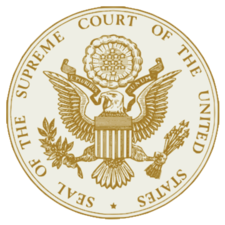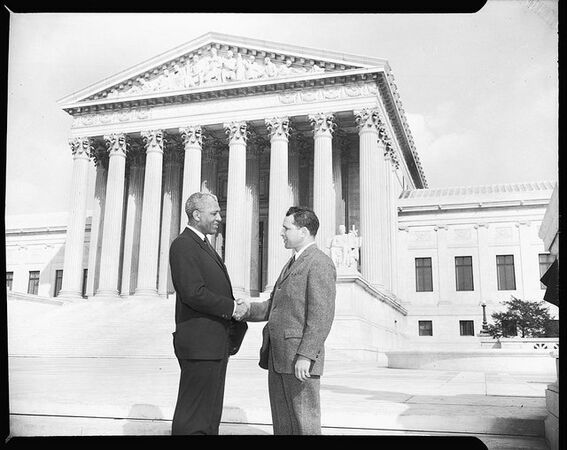Andy Warhol Foundation for the Visual Arts, Inc. v. Goldsmith
 | |
| Andy Warhol Foundation for the Visual Arts, Inc. v. Goldsmith | |
| Term: 2022 | |
| Important Dates | |
| Argued: October 12, 2022 Decided: May 18, 2023 | |
| Outcome | |
| affirmed | |
| Vote | |
| 7-2 | |
| Majority | |
| Sonia Sotomayor • Clarence Thomas • Samuel Alito • Neil Gorsuch • Brett Kavanaugh • Amy Coney Barrett • Ketanji Brown Jackson | |
| Concurring | |
| Neil Gorsuch | |
| Dissenting | |
| Elena Kagan • Chief Justice John Roberts | |
Andy Warhol Foundation for the Visual Arts, Inc. v. Goldsmith is a case that was decided by the Supreme Court of the United States on May 18, 2023, during the court's October 2022-2023 term. The case was argued before the Supreme Court of the United States on October 12, 2022.
In a 7-2 opinion, the court ruled in Goldsmith's favor and affirmed the judgment of the United States Court of Appeals for the 2nd Circuit. It held that regarding 17 U.S.C. § 107, the “purpose and character" of the Andy Warhol Foundation's commercial use of Goldsmith’s photo infringes on Goldsmith's copyright. Justice Sonia Sotomayor delivered the majority opinion of the court. Justice Neil Gorsuch filed a concurring opinion. Justice Elena Kagan filed a dissenting opinion, joined by Chief Justice John Roberts.[1]
The case came on a writ of certiorari to the United States Court of Appeals for the 2nd Circuit. To review the lower court's opinion, click here.
Timeline
The following timeline details key events in this case:
- May 18, 2028: The U.S. Supreme Court affirmed the judgment of the United States Court of Appeals for the 2nd Circuit.
- October 12, 2022: The U.S. Supreme Court heard oral argument.
- March 28, 2022: The U.S. Supreme Court agreed to hear the case.
- December 9, 2021: The Andy Warhol Foundation for the Visual Arts (the petitioner) appealed to the U.S. Supreme Court.
- September 10, 2021: The U.S. Court of Appeals for the 2nd Circuit denied a petition for a hearing en banc.
- August 24, 2021: The 2nd Circuit withdrew the original opinion and entered an amended opinion.
- March 26, 2021: The 2nd Circuit reversed the judgment of the U.S. District Court for the Southern District of New York.
Background
In 1984, Vanity Fair commissioned artist Andy Warhol to create an image of the musician, Prince, for a magazine article. The magazine licensed a photograph taken by respondent Lynn Goldsmith. Using Goldsmith's photograph as a base, Warhol then produced the Prince Series—a set of 15 images of Prince based on Goldsmith's preexisting photo. Prince died in 2016 and Condé Nast magazine published an issue with one of the images from the Prince Series on the cover. After seeing the issue, Goldsmith threatened to sue the Andy Warhol Foundation (AWF), which held the rights to the Prince Series, alleging copyright infringement. AWF sued Goldsmith for a declaration of non-infringement and Goldsmith countersued for copyright infringement under the Copyright Act.[3]
The U.S. District Court for the Southern District of New York granted summary judgment to AWF, ruling the Prince Series was "transformative" as a matter of law. According to the court, the Prince Series relied on a different meaning and message from Goldsmith's original photograph. On appeal, the U.S. Court of Appeals for the 2nd Circuit reversed the Southern District of New York's ruling. Ten days after the 2nd Circuit's ruling, the U.S. Supreme Court issued a decision considering the fair use doctrine in Google LLC v. Oracle America Inc. AWF petitioned the 2nd Circuit for an en banc rehearing. The 2nd Circuit granted the request and issued an amended opinion.[3]
In their petition for review before the U.S. Supreme Court, AWF argued that the fair use defense "ensures that the Copyright Act does not stymie legitimate creative expression."[3]
The petitioner asked the U.S. Supreme Court to grant review to resolve a conflict of opinion among the U.S. Circuit Courts of Appeal.
Fair Use and the Copyright Act
The Copyright Act (917 U.S. Code § 107) authorizes the public to make fair use of copyrighted content. The law outlines four factors for determining whether the use of a work is fair use:
- the purpose and the character of the use;
- the nature of the copyrighted work;
- the amount and significance of the portion of the original work used; and
- the effect of the use upon the potential market for the value of the original work.
Questions presented
The petitioner presented the following questions to the court:[4]
Questions presented:
|
Oral argument
Audio
Audio of oral argument:[6]
Transcript
Transcript of oral argument:[7]
Outcome
In this case, the Supreme Court was asked to determine if the images that Andy Warhol based on a photograph of Prince by photographer Lynn Goldsmith were a fair use of the photo and that the Warhol Foundation could use them for commercial purposes without Goldsmith's permission.[8]
In a 7-2 opinion, the court ruled in Goldsmith's favor and affirmed the judgment of the United States Court of Appeals for the 2nd Circuit. It held that regarding 17 U.S.C. § 107, the “purpose and character" of the Andy Warhol Foundation's commercial use of Goldsmith’s photo infringes on Goldsmith's copyright. Justice Sonia Sotomayor delivered the opinion of the court.[1]
Opinion
In the court's majority opinion, Justice Sonia Sotomayor wrote:[1]
| “ | But the first fair use factor instead focuses on whether an allegedly infringing use has a further purpose or different character, which is a matter of degree, and the degree of difference must be weighed against other considerations, like commercialism. Campbell v. Acuff-Rose Music, Inc., 510 U. S. 569, 579 (1994). Although new expression may be relevant to whether a copying use has a sufficiently distinct purpose or character, it is not, without more, dispositive of the first factor.
Here, the specific use of Goldsmith’s photograph alleged to infringe her copyright is AWF’s licensing of Orange Prince to Condé Nast. As portraits of Prince used to depict Prince in magazine stories about Prince, the original photograph and AWF’s copying use of it share substantially the same purpose. Moreover, the copying use is of a commercial nature. Even though Orange Prince adds new expression to Goldsmith’s photograph, as the District Court found, this Court agrees with the Court of Appeals that, in the context of the challenged use, the first fair use factor still favors Goldsmith. [5] |
” |
| —Justice Sonia Sotomayor | ||
Concurring opinion
Justice Neil Gorsuch filed a concurring opinion, joined by Justice Ketanji Brown Jackson.
In his concurring opinion, Justice Neil Gorsuch wrote:[1]
| “ | With all this in mind, the Court’s decision seems to me exactly right. Does Mr. Warhol’s image seek to depict Prince as a “larger-than-life” icon while Ms. Goldsmith’s photograph attempts to cast him in a more “vulnerable” light? See ante, at 28–35; post, at 9–10, 35 (KAGAN, J., dissenting). Or are the artistic purposes latent in the two images and their aesthetic character actually more similar than that? Happily, the law does not require judges to tangle with questions so far beyond our competence. Instead, the first fair-use factor requires courts to assess only whether the purpose and character of the challenged use is the same as a protected use. And here, the undisputed facts reveal that the Foundation sought to use its image as a commercial substitute for Ms. Goldsmith’s photograph. Of course, competitive products often differ in material respects and a buyer may find these differences reason to prefer one offering over another. Cf. post, at 10, 18 (KAGAN, J., dissenting). But under the first fair-use factor the salient point is that the purpose and character of the Foundation’s use involved competition with Ms. Goldsmith’s image. To know that much is to know the first fair-use factor favors Ms. Goldsmith.[5] | ” |
| —Justice Neil Gorsuch | ||
Dissenting opinion
Justice Elena Kagan filed a dissenting opinion, joined by Chief Justice John Roberts.
In her dissent, Justice Elena Kagan wrote:[1]
| “ | Still more troubling are the consequences of today’s ruling for other artists. If Warhol does not get credit for transformative copying, who will? And when artists less famous than Warhol cannot benefit from fair use, it will matter even more. Goldsmith would probably have granted Warhol a license with few conditions, and for a price well within his budget. But as our precedents show, licensors sometimes place stringent limits on follow-on uses, especially to prevent kinds of expression they disapprove. And licensors may charge fees that prevent many or most artists from gaining access to original works. Of course, that is all well and good if an artist wants merely to copy the original and market it as his own. Preventing those uses—and thus incentivizing the creation of original works—is what copyrights are for. But when the artist wants to make a transformative use, a different issue is presented. By now, the reason why should be obvious. “Inhibit[ing] subsequent writers” and artists from “improv[ing] upon prior works”— as the majority does today—will “frustrate the very ends sought to be attained” by copyright law. Harper & Row, 471 U. S., at 549. It will stifle creativity of every sort. It will impede new art and music and literature. It will thwart the expression of new ideas and the attainment of new knowledge. It will make our world poorer. | ” |
| —Justice Elena Kagan | ||
Text of the opinion
Read the full opinion here.
October term 2022-2023
The Supreme Court began hearing cases for the term on October 3, 2022. The court's yearly term begins on the first Monday in October and lasts until the first Monday in October the following year. The court generally releases the majority of its decisions in mid-June.[9]
See also
External links
- Search Google News for this topic
- U.S. Supreme Court docket file - Andy Warhol Foundation for the Visual Arts, Inc. v. Goldsmith (petitions, motions, briefs, opinions, and attorneys)
- SCOTUSblog case file for Andy Warhol Foundation for the Visual Arts, Inc. v. Goldsmith
Footnotes
- ↑ 1.0 1.1 1.2 1.3 1.4 1.5 Supreme Court of the United States,Andy Warhol Foundation for the Visual Arts Inc v. Goldsmith May 22, 2023
- ↑ SCOTUSblog, "Justices add three new cases, including challenge to animal-welfare law and Warhol copyright dispute," March 28, 2022
- ↑ 3.0 3.1 3.2 Supreme Court of the United States, Andy Warhol Foundation for the Visual Arts v. Goldsmith - "Petition for a writ of certiorari," accessed March 28, 2022
- ↑ Supreme Court of the United States, Andy Warhol Foundation for the Visual Arts, Inc. v. Goldsmith - "Questions presented," accessed March 28, 2022
- ↑ 5.0 5.1 5.2 5.3 Note: This text is quoted verbatim from the original source. Any inconsistencies are attributable to the original source.
- ↑ Supreme Court of the United States, "Oral Argument - Audio," argued October 12, 2022
- ↑ Supreme Court of the United States, "Oral Argument - Transcript," argued October 12, 2022
- ↑ SCOTUSblog Justices debate whether Warhol image is “fair use” of photograph of Prince May 22, 2023
- ↑ SupremeCourt.gov, "The Supreme Court at Work: The Term and Caseload," accessed January 24, 2022
| |||||||||||












